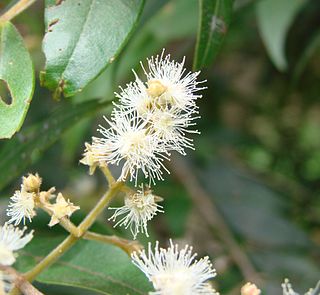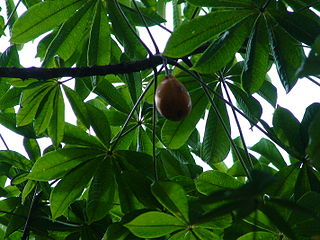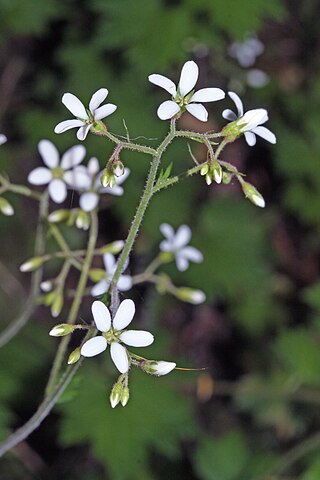| Perebea | |
|---|---|
| Scientific classification | |
| Kingdom: | Plantae |
| Clade: | Tracheophytes |
| Clade: | Angiosperms |
| Clade: | Eudicots |
| Clade: | Rosids |
| Order: | Rosales |
| Family: | Moraceae |
| Genus: | Perebea Aubl. [1] |
| Species | |
See text. | |
| Perebea | |
|---|---|
| Scientific classification | |
| Kingdom: | Plantae |
| Clade: | Tracheophytes |
| Clade: | Angiosperms |
| Clade: | Eudicots |
| Clade: | Rosids |
| Order: | Rosales |
| Family: | Moraceae |
| Genus: | Perebea Aubl. [1] |
| Species | |
See text. | |

The Moraceae—often called the mulberry family or fig family—are a family of flowering plants comprising about 38 genera and over 1100 species. Most are widespread in tropical and subtropical regions, less so in temperate climates; however, their distribution is cosmopolitan overall. The only synapomorphy within the Moraceae is presence of laticifers and milky sap in all parenchymatous tissues, but generally useful field characters include two carpels sometimes with one reduced, compound inconspicuous flowers, and compound fruits. The family includes well-known plants such as the fig, banyan, breadfruit, jackfruit, mulberry, and Osage orange. The 'flowers' of Moraceae are often pseudanthia.

Vismia is a genus of flowering plants in the family Hypericaceae. Members of the genus are small trees and shrubs found in tropical and subtropical areas of Central America and South America. Including the countries of Belize, Bolivia, Brazil, Colombia, Costa Rica, Ecuador, El Salvador, French Guiana, Guatemala, Guyana, Honduras, Mexico, Nicaragua, Panamá, Peru, Suriname, Trinidad-Tobago and Venezuela.

Agathosma is a genus of about 140 species of flowering plants in the family Rutaceae, native to the southern part of Africa. Common names include buchu, boegoe, bucco, bookoo and diosma. Buchu formally denotes two herbal species, prized for their fragrance and medicinal use despite their toxicity. In colloquial use however, the term is applied to a wider set of fragrant shrubs or substitutes.

Juniperus procera is a coniferous tree native to mountainous areas in Africa and the Arabian Peninsula. It is a characteristic tree of the Afromontane flora.

Myrcia is a genus of plants in the family Myrtaceae, containing about 765 species as of 2022. They are distributed in Central and South America, Mexico, and the Caribbean, with centers of diversity in the Brazilian Cerrado and Atlantic Forests ecoregions. Myrcia was first described as a genus in 1827.

Balaka seemannii is a species of flowering plant in the family Arecaceae that is endemic to Fiji; growing in mixed forests on Vanua Levu and Taveuni islands.
Magnolia wolfii is a tree species in the family Magnoliaceae. It is endemic to Colombia. The species is recorded only from one locality in Risaralda Department. The species is being investigated by a conservation and propagation research program implemented by the Technological University of Pereira, with the support of Botanic Gardens Conservation International.
Pseudolmedia is a flowering plant genus in the mulberry family (Moraceae). Species are found in southern Mexico, the Caribbean, and Meso- and South America. They are known in Latin America as lechechiva and used for timber, construction wood, and sometimes in folk medicine.

Renealmia is a plant genus in the family Zingiberaceae. Its members are native to tropical Africa and tropical America. In Peru, fruits and tubers are sources of indigenous dyes. and indigenous medical treatments for leishmania and malaria In Colombia, it is used to treat snakebite. Bracts and leaves can serve as phytotelmata, retaining small quantities of water that offer habitat for other organisms.
Sauropus assimilis is an extremely rare species of plant in the family Phyllanthaceae. It is a tree growing in wet evergreen forests in lowlands. Endemic to southwestern Sri Lanka, and only known from the Sinharaja Biosphere Reserve there, evidence of its existence was last catalogued before 1991, and it has not been found since then. It may since have become extinct.

Jacaratia is a genus of shrubs or trees in the family Caricaceae. They are native to South and Central America.

Boykinia is a small genus of plants related to the saxifrages. It contains at least nine species, known as brookfoams. Brookfoams are glandular rhizomatous creeping perennials with highly lobed or toothed leaves and inflorescences of petite flowers. They are native to North America and Asia.

Ficus americana, commonly known as the West Indian laurel fig or Jamaican cherry fig, is a tree in the family Moraceae which is native to the Caribbean, Mexico in the north, through Central and South America south to southern Brazil. It is an introduced species in Florida, USA. The species is variable; the five recognised subspecies were previously placed in a large number of other species.

Vella is a genus of plants in the family Brassicaceae, under which there are no fewer than six species. Species are many branched, and have hairy, sessile, entire leaves that are narrower in width at their bases, widening out to form ovals. Fruits are stiff follicles. Vella is endemic to that area of land encompassing Algeria, Morocco, and Spain.
Cyrtandra cleopatrae is a species of plant in the family Gesneriaceae endemic to the Philippines. It is a tropical shrub having recaulescent inflorescences composed of multiple purpled flowers that emerge on the plant stem from stubby shoots. It was first collected for science during a 1998 expedition sponsored by the Royal Botanic Garden Edinburgh, from a location in Palawan called Cleopatra's Needle (elev. 1550m), thus the specific epithet "cleopatrae". The taxon was first published in the Edinburgh Journal of Botany in 2001.

Maxillaria parviflora, the purple tiger orchid, is a species of epiphytic orchid native to Florida, the West Indies and through Latin America from Mexico to Bolivia.
Moutabea is a neotropical genus of Polygalaceae with about 10 species. It was first described in 1775 by Jean Aublet.
Maquira is a genus of trees in the family Moraceae, native to South America.

Ochetophila is a genus of flowering plants in the family Rhamnaceae, native to Chile and Argentina. The species in this genus are actinorhizal plants.

Coussapoa is a genus of flowering plants belonging to the family Urticaceae.
Type Specimens: T: Perebea guianensis Aubl.